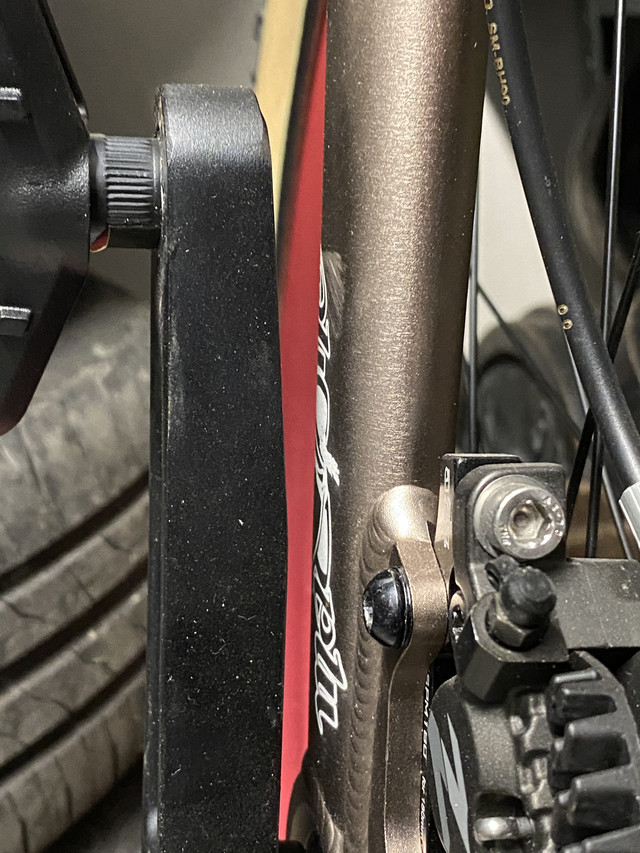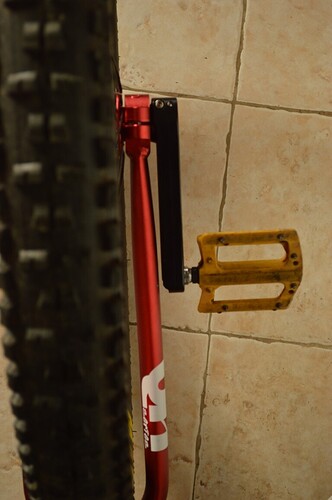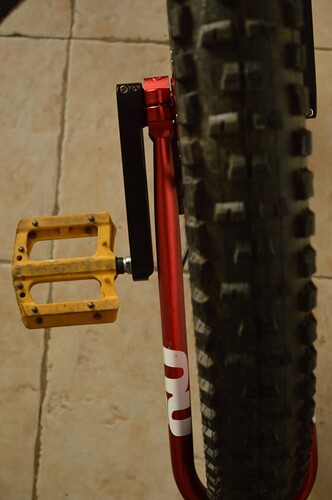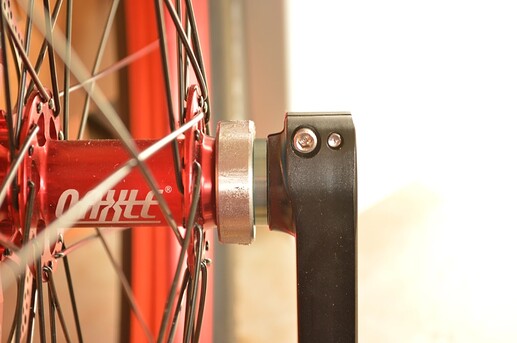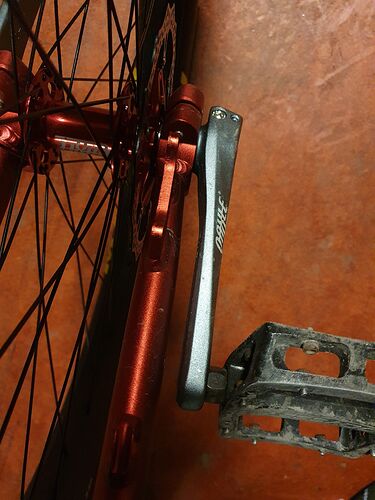I think I’d like to see some empirical testing here. There are absolutely differences from brand to brand and product to product but I’m not sure that saying one is or isn’t stiff enough is entirely fair (and I’m saying this as someone who’s seemingly managed to bend an RGB frame enough to smash it into a crank…).
Just took a photo of my quaxle wheel and cranks in the M41 frame. It’s close there as well, but most importantly the cranks are moving outwards further away from the axle. That makes me wonder where your crank has hit the frame. Was it at the end of the crank where the pedal is, or more at the base?
Apropos of the crank hitting the frame - I put a pretty significant dent into my cyclocross bike’s chainstay doing exactly that. There was well over a centimeter clearance, and squeezing it together by hand I can’t even close half the gap. But a big crash did it. And it didn’t just scratch it, it put a big enough dent that I was worried the frame would fail.
Anyway I think it’s not a sign of bad design, just bad luck.
And apropos of the general subject - I have a QX series 27.5+, and everything about it seemed really well made. No quality control issues. Over the years it’s developed a little bit of play in the right side crank (my back foot, so it sees a lot of force in both directions), but I’ve had issues with my ISIS cranks, too. I think the back side crank just leads a hard life if you do any hopping or dropping.
Ooooh, that picture’s fascinating.
So my cranks aren’t set back like that from the centre to the end - they’re straight all the way along, that makes it much closer to the frame, especially when they’re this long.
Perhaps mine are an old stock design that has been improved.
Edit: Apparently the angle on the back is to reduce injury in flatland as 137s are common there.
Basically it sounds like if I’d got 137s my life would be all sunshine and rainbows.
Here’s a picture of mine both on the left and right side, and showing the frame leg shape as a whole.
As you can see, the gap is identical on both sides, as is the tyre gap (from earlier discussion, my wheel is pretty centred and I haven’t fiddled with it yet.
So, mine are most definitely the silver ones, snugged up and installed correctly:
And on weight, mine is almost exactly 6kg (weighed in parts on my kitchen scales, which were checked for accuracy against my coffee scales) compared to the 5.6kg listed on the website.
I’ve still got my Nukeproof Electrons on, but if anything I’d expect them to be lighter than the stock pedals, certainly not 400g difference if they’re heavier.
So when I had my cranks off, I did a test and nipped them up so that they were locked onto the axle but not really tight, then tried to see if I could get the splines to lock into place with each other before the circular clamping force itself was seemingly the thing holding the crank super solid.
The answer was no. The splines on the crank appear to maybe be marginally different to the splines on the hub, so there is seemingly some rotational play even when brand new, until you clamp it up hard.
Perhaps when tightened up really hard the splines seat into each other perfectly, I don’t know.
I also found that my cranks were loose to put on and take off when the bolts were undone, which was in contrast to what I expected from the Qu-Ax tips video about using a coin to force the interface apart to make removing/reinstalling easier.
I know the interface is tried and tested on bikes, but surely on a bike the force is typically all in one direction, aside from when going downhill with your crank position locked when one of the cranks will have a force applied to the splines in the opposite direction. Most of the time I’d also expect this force to be rather less than on a unicycle as your weight is spread between the two cranks and the bottom bracket will be rotating freely.
It seems like quite different use case to the constantly changing force direction on a unicycle.
With your cranks, can you not tighten it up enough to lock it in place/stop that play now? Is there noticeable wear on the crank interface itself?
that’s very narrow indeed!
I read this thread the day after ordering a QX RGB 27.5", and I got a bit anxious… but after a few rides, I’m happy to say that I’m very satisfied. There are no signs of problems with the build quality – the thing seems very well made.
I chose the 125/145 mm cranks and they seem to slant away from the frame more than the 137s do (pictures below). There is just under a centimeter of clearing at the pedal, which should be plenty.
My only complaint is the cheap plastic pedals. But pedals being the easiest component to switch on a unicycle (as I have done), this is really a minor issue.
I hope your post (and no doubt others like it to come and elsewhere) calm the nerves of anyone in a similar situation.
I don’t think that it’s a bad unicycle, in fact it’s probably my second favourite unicycle (I love my big wheels so the KH36 takes the top spot) right now despite the issues I’ve had, but my default position with anything is a critical one!
So to be clear, mine are the Zero-Q 145mm. The 137s slope away as @mark.vogels picture shows above and have a far more sensible seeming amount of clearance.
What I will probably do with mine is machine/file away the back to give more clearance, however unlikely it might be that they’d hit the frame again.
My bad! Mine are the Q-Axle Dual, then. I would recommend buying new cranks, if it weren’t for the extremely high prices (71€ for cranks?!).
Believe it or not, that is middle of the market for good splined (unicycle) cranks… Sucks, but I guess the fairly low numbers (especially for each size), make them a bit more pricey to get produced than bike cranks…
commenting on the hub only:
I can confirm bad bearings. After just a year of moderate usage and good care they surprisingly got rust and noticeably higher friction.
Having less bearing space and thus smaller bearing balls is a design disadvantage. Vulnerability to rust is a material issue. For ISIS’ bearing size (20x42x12) you can find lots of supply (thus presumably good quality for little money), unlike for the Q-axle bearing size (24x42x12; might have been produced on demand?).
I can also confirm on the metal shavings falling off of the hub splines. That made me wonder “why?” but it didn’t turn out to be a mechanical issue yet.
personal note:
It’s nice stuff, might have been a bit overhyped though – so it’s helpful to hear about existing issues and valid concerns as well.
Yeah I had a bit of a look around for replacements (not through Qu-Ax)/alternatives and didn’t find much, even through quirky eBay sellers who’ve supplied me with all sorts of odd bearings in the past.
the bearings have been massively improved since the first batch.
The metal shavings are cosmetic, but no technical issue. we are working on an improvement.
I’ve had only one issue with my RGB 27.5", but it’s an annoying one: Both screws in the seat post clamp have snapped when tightening the clamp, one last Sunday, the other a few weeks ago. I’ve had to drill out the remaining bit, leading to much frustration and uttering of curses.
I can’t say for sure that I haven’t overtightened the screws, but this being the first time it’s happened to me in my ~15 years of bike repair experience, it seems like too much of a coincidence that both snapped. I was also surprised that Qu-Ax went for M5 and not M6 screws here.
Does anyone else have similar experiences?
I’m no metallurgist, but the screw looks rusty inside (or is that just the lack of anodising on the inside?):
Ooof, that’s no good. Looks like they might need to start using some higher quality machine screws.
I must make a note to remind myself to change mine.
Maybe send Qu-Ax an email and see if they’ve seen similar? Most people would not have the skills to drill out such a screw and personally I’d not be inclined to say this is user error.
M5 screws on seat and other tube clamps are not unheard of though. Most handlebar clamps are M5 and there are other seat clamps out there using them too, especially in the bike world.
I have expected the clamp threads to strip before the screw sheared, especially into aluminium even if it is an anodised 7050 alloy.
I’d also expect the hex to round out before the bolt sheared - indeed I’ve had this happen before with small screws even when using good quality (correctly sized) allen keys. I’m sure with bike repair experience you’ve seen similar over the years!
Regarding the failure, as far as I know most machine screws are made from bar stock with forged heads and rolled threads, then heat treated and plated as necessary.
These appear to be zinc plated steel, so it’s definitely possible that there is some rust where the screw has sheared, but if so it’ll likely have happened following the shear rather than before.
I’ll do that.
I agree, but a unicycle seat post takes a pretty big beating compared to regular bike seat posts (at least mine does).
Agreed. It didn’t take much force, either – almost as if the screws had been damaged by some mysterious, external force…
Make that amateur, hobby based bike repair experience ![]()
first bolt of a seatclamp that I see like this, sorry for the bad experience. Did you tighten alternately evenly? A bit of grease on the thread is helpful (normally preinstalled!).
@mowcius our wheels are handbuilt. From what I know, there is no machine in the world being able to built unicycle wheels. However, on a unicycle even more than on a bike, retightening the spokes after some first riding is recommended.
I think this is something that could with some greater publicising as a lot of people regularly treat their unicycles as a “built and now good forever” situation. A learner 20" will probably be fine, but once you’re spending a few hundred pounds a bit of preventative maintenance after 6 months can go a long way.
The potential for seizing is something I hadn’t thought of. I’ve definitely sheared off similarly sized bolts that have seized.
Yes, I tightened them alternately. The bolts never seized, so I don’t see how grease would help in this case.
I’d replace them with grade 8 bolts. Then if something fails it will be the clamp.
